Chalk Magic
 “Vera, Vera! Come see how bright the colors are in my rainbow!” Four-year-old Owen is ecstatic about his discovery of a colorful collection of wet chalk after a summer shower in our outdoor classroom. This happy accident has paved the way for a sensory adventure as we meet our math and science early learning standards through play.
“Vera, Vera! Come see how bright the colors are in my rainbow!” Four-year-old Owen is ecstatic about his discovery of a colorful collection of wet chalk after a summer shower in our outdoor classroom. This happy accident has paved the way for a sensory adventure as we meet our math and science early learning standards through play.
Owen is our engineer of playful learning. “This chalk feels different and it is so smooth to write on the sidewalk. Hurry, Vera!”
Owen is our full-of-life friend who loves to explore and discover and test out new ideas. He will extend the play until it’s time to leave or his stomach begins to rumble with hunger. He is also great at retaining the lessons he has learned for future exploration and discovery. Owen is our poster child for scientific investigation and math foundation!
“Owen, you can blend all of the colors! Do it with your feet!” Vera shouts back.
Vera is Owen’s partner in crime. There is nothing that beats the joy of childhood summers and outdoor learning. We don’t need worksheets to meet our early learning standards. We just need time to investigate, explore and experiment with a little bit of water, a bucket of chalk and our favorite friends. Water turns sidewalk chalk into an entirely different medium—transforming a dry and dusty classroom staple into a creamy and vibrant tool of creative expression. Trust me: Wet chalk will open up new avenues of imagination, exploration and learning in the preschool brain!
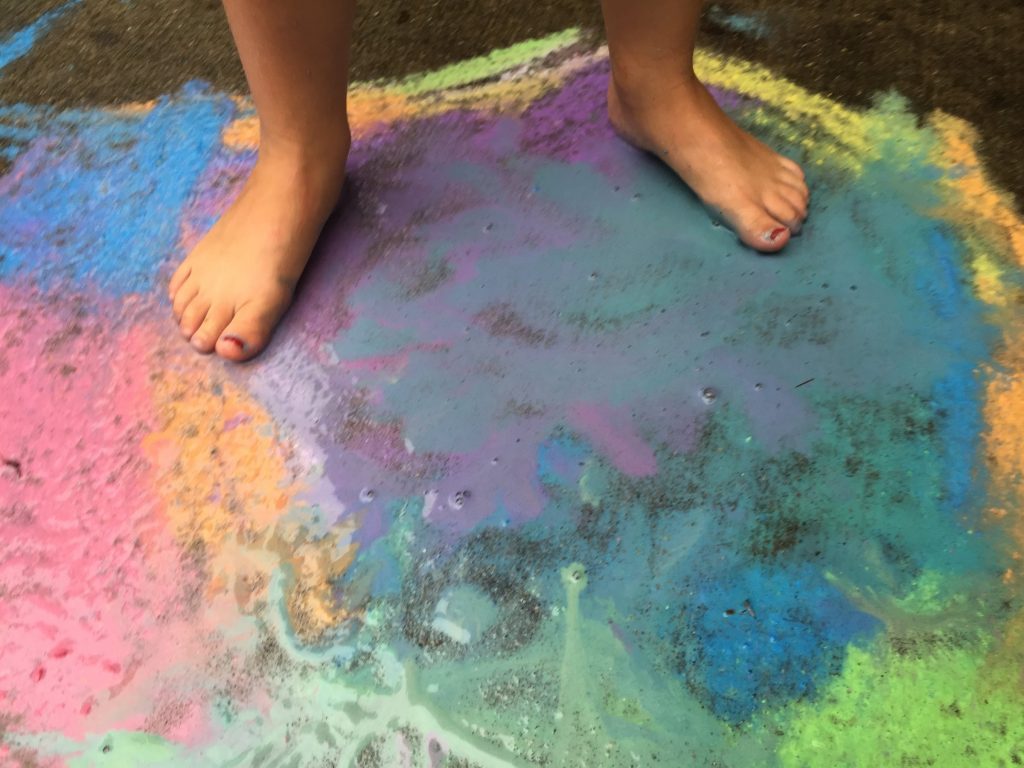
“Parker! Can you draw a person using shapes?” asks Avery, prompting her creative collaborator to tackle a new challenge. Here come our math standards, sneaking their way back into our play. Math vocabulary is exploding in our outdoor classroom. We are suddenly discussing lines and patterns and shapes and sizes. Blending is a form of addition, grouping, sets and prediction.
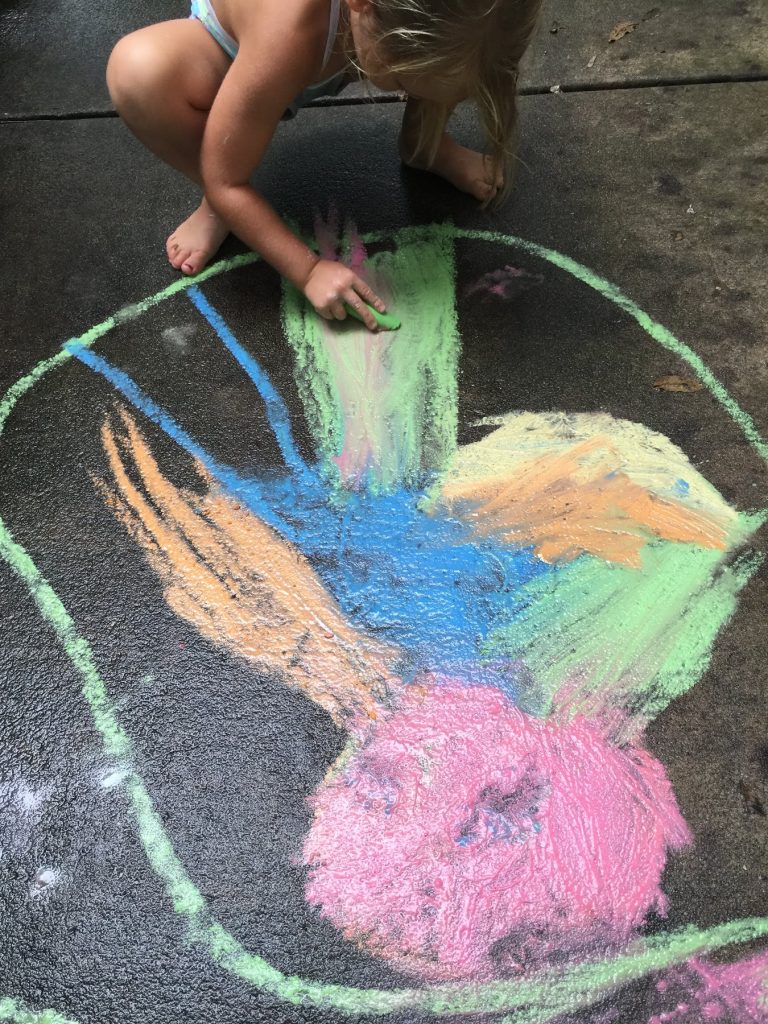
“I think the chalk will dry lighter,” Owen predicts as Vera nods in agreement.
“Why?” asks three-year-old Avery.
“Because the color of the dry chalk in the basket is lighter than the wet chalk on the sidewalk,” Owen answers. “Let’s try it!”
At Owen’s prompting, the children run off to conduct their latest experiment.
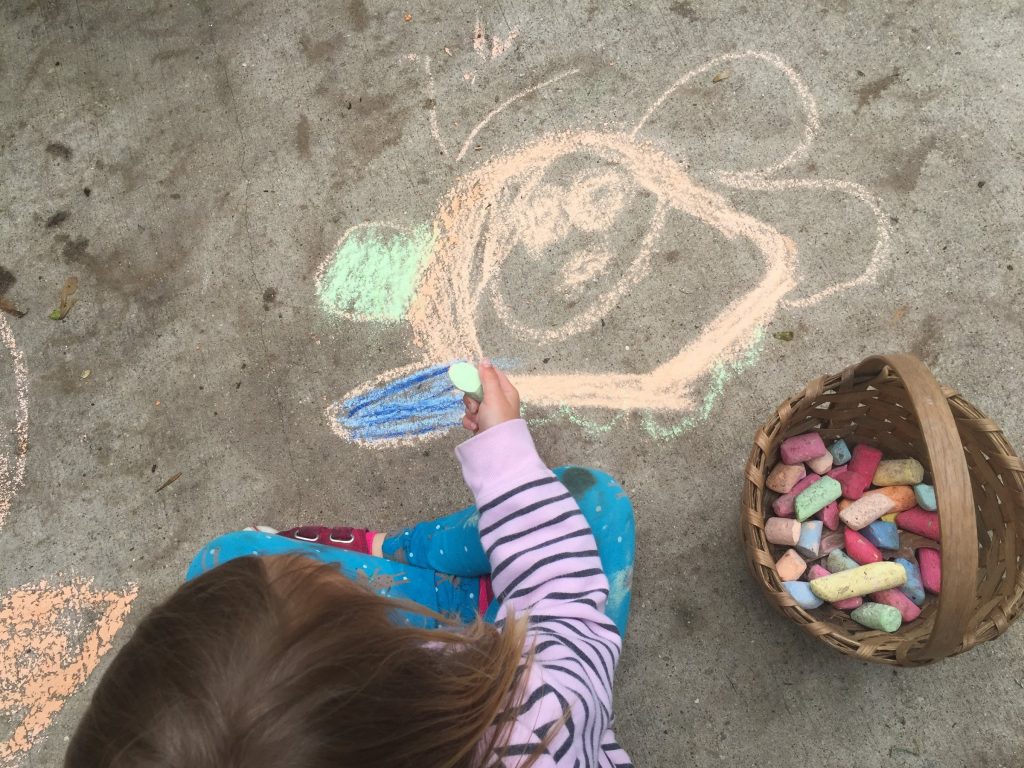
Ah, yes. The wet chalk has presented us with a priceless teaching-and-learning moment initiated and carried out by the children in our program. We have science as we observe, ask questions, problem-solve and draw conclusions. We have cause and effect, data analysis and design as the group tests out its theory. The mathematical and scientific inquiry has begun—and a whole new chapter of learning has become our curriculum for the day. This is why early childhood educators create their lesson plans at the end of the day—to build on the day’s explorations and extend them into the following day’s lessons. This is child-led learning!

Today, we have chalk investigative play happening. Our children discuss textures and exchange observations as they collaborate on their art in progress. Through their play with wet chalk, the children are describing and comparing physical properties. They are exploring concepts of force and motion as they draw with different amounts of pressure or drop dry pieces of chalk onto the sidewalk to create chalk bombs that explode on impact.
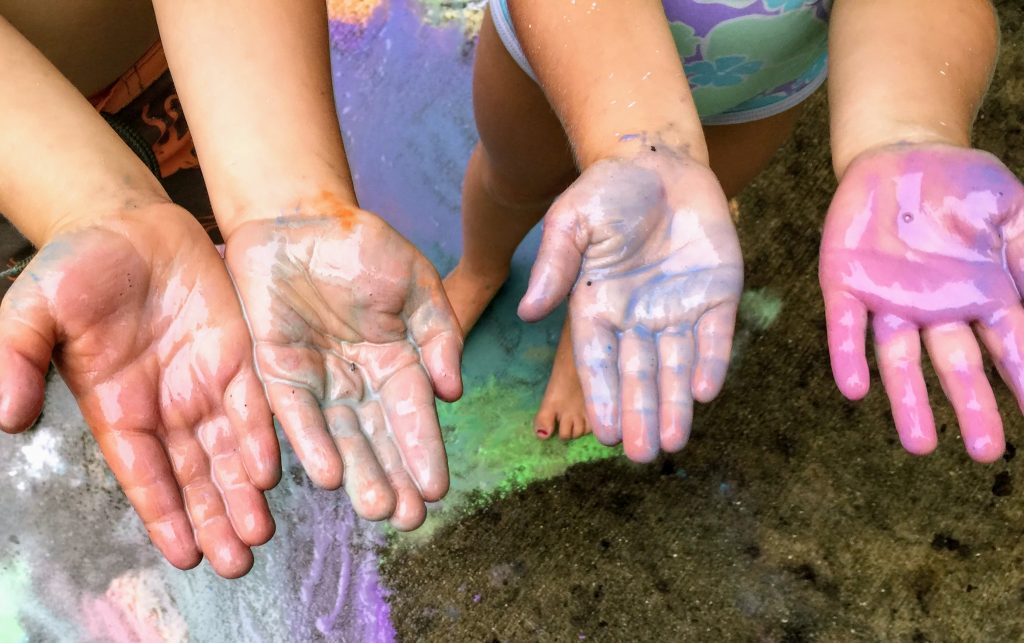
We spend a lot of time discussing math and science early learning standards here. But our day of chalk play also played an important role in preparing the children in our program for a successful transition to kindergarten.
Following are a few insights into the hidden benefits of chalk play—insights that can be shared with parents who may question the value of outdoor play and its role in advancing their children’s kindergarten readiness:
Kindergarten, sadly, involves a lot of sitting time. Children need strength throughout their bodies—including strong core muscles to sit all day. When children get down on their hands and knees and support their upper-body weight with their arms and hands, this strengthens their core muscles, as well as their shoulder muscles, which are so important for fine-motor dexterity. Small pieces of chalk promote the development of the tripod grasp needed for pencil gripping. Drawing big chalk rainbow arches requires children to cross the midline. Why is this so important? Kindergarteners need midline-crossing skills so that the dominant hand can efficiently move from left to right across the page.
These are all bonuses for kindergarten readiness—above and beyond the early learning standards. This is the foundation that we talk about when we play our way into academic life. These small steps will enable our children to succeed when it’s time to sit at a desk.
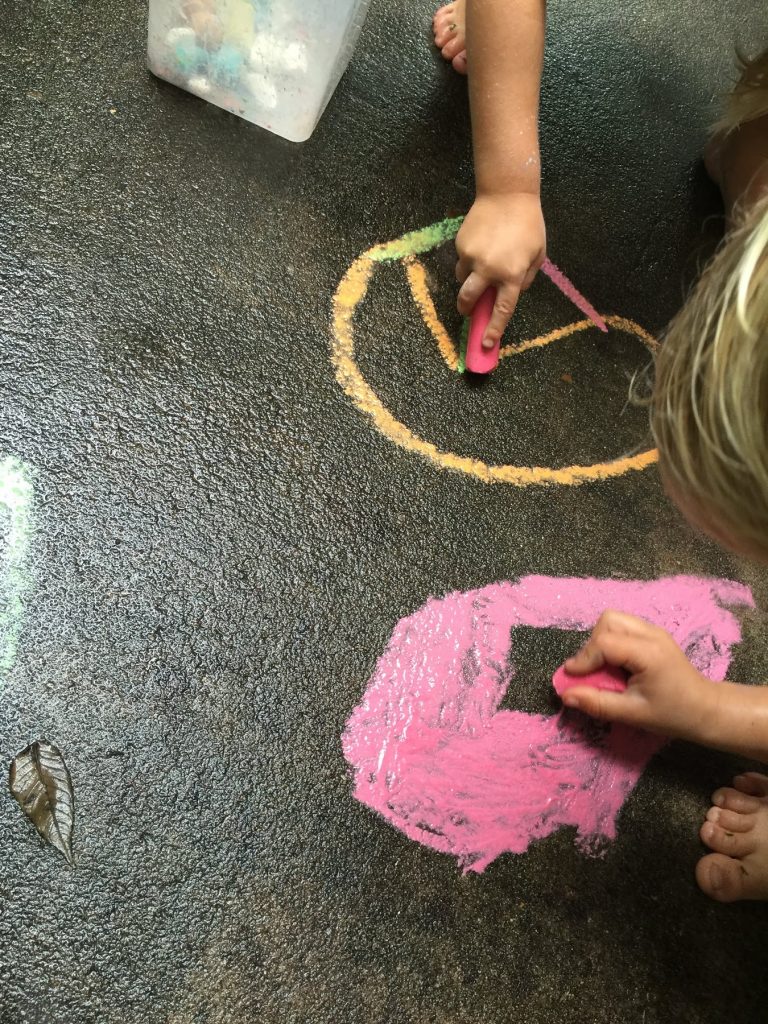
“My chalk is shrinking really fast!” giggles Rowan.
Oh, how I love shrinking chalk! Yes, we are definitely collecting data, making observations and noticing cause and effect. But there’s more happening here than meets the eye. We know that the transition to smaller writing utensils helps promote the development of better gripping skills. As the children continue to draw and their pieces of sidewalk chalk get shorter and smaller, they are effectively transitioning to smaller writing tools and strengthening their gripping skills. We try not to rush writing in our young learners. But when it happens spontaneously, we try to promote the use of smaller pieces of chalk, crayons or pencils to help them develop age-appropriate gripping skills.

You never know where play will lead your little learners. But trust that there will be learning happening as the children share insights and ideas while building strong and trusting friendships. So let the children play in their outdoor classroom—and join in the “alfresco fun” as you meet your early learning standards!
A simple activity that can create so many opportunities for math language.
Children love sidewalk chalk. These children are doing math and science through play.
I loved how the wet chalk play was great concept for the children and taught some interesting things along the way.
This looks so like so much fun.
Oh, what fun!!
This is so cool!!
I thought their were good points in this article. it is something we could engage in our classroom.
I like the idea of wet chalk. I can definitely use this as a sensory activity in class.
I like the idea of the children exploring with the chalk dry and wet and to see the different shades that each brings and the different textures that they are .
It was interesting to see how the children looked at the colors. I can see how many different skills and learning areas were involved in the play with just a few pieces of sidewalk chalk. What a learning experience for all the kids.
I do love to explore the different textures and ways of using things. I don’t necessarily like the fact of wet chalk though. half of my children in my classroom do not like thing that stick to their hands I doubt they would even want to touch it since it is wet. I still think it could be worth a try.
I love the idea of different textures.
This would be a great outdoor activity!
Such happy accidents this is a great activity for problem solving.
What a fun simple way to teach children about colors, math and patterns.
I will definitely be doing this with my daycare children!
such a fun activity to learn such a deep concept
THIS WILL BE A GREAT ENGAGEMENT IN A CLASSROOM BECAUSE IT IS A FUN ACTIVITY
This would be a great activity for my preschoolers!
it is awesome to have the children see what happens when the chalk becomes wet.
Chalk is great for learning !
Chalk can provide so many learning opportunities. We will use the wet chalk activity in our sensory table.
our kids absolutely love doing this, the messier the better
Kids having fun, but also learning thru play! Love this❤️
Shapes mixed with art! Being intentional about naming shapes is beneficial.